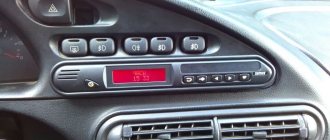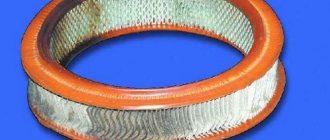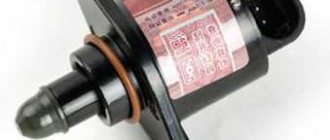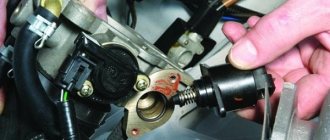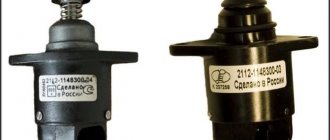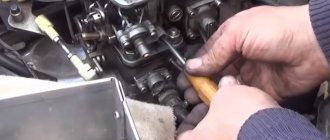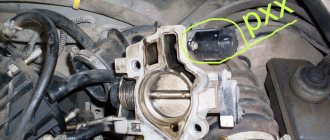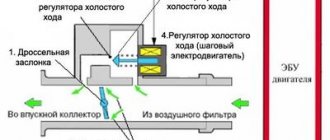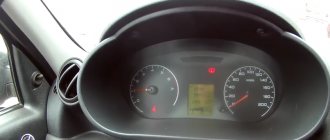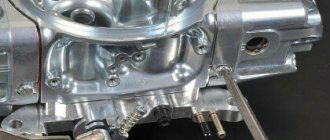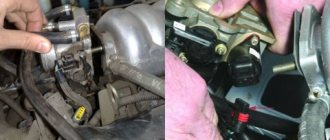Why does the engine speed fluctuate?
The easiest way to find out about problems with the “iron heart” is by looking at the tachometer (the norm is 800 rpm, difficulties occur when fluctuating from 500 to 1500 rpm).
You can recognize difficulties by the rising and falling sounds. Why does the engine speed fluctuate at idle? It appears in injectors, where the idle is regulated by the ECU (electronic “brain”). It processes information about the failure and gives a signal to the sensors to normalize technical indicators.
Possible reasons why the idle speed fluctuates:
- air has entered the cylinders (to equalize the fuel-air mixture, the ECU sends a command to supply more fuel to the cylinders - the speed increases, the ECU detects the excess fuel and reduces its supply);
- The IAC, which stabilizes the “idle” vehicle, has broken down;
- the crankcase ventilation valve does not work (excess exhaust air masses move to the manifold; when wedged due to oil leaks, the fuel-air mixture is not filled with the “volatile” component to the required extent - the speed jumps from 1100 to 800 rpm);
- The mass air flow sensor broke down due to oil waste. The “brains” do not receive reliable data on the amount of incoming air, they give an erroneous command - the speed begins to fluctuate;
- Throttle valve error (regulates pressure) due to clogged or broken actuator.
The reasons why the speed drops when cold is described above (including during startup).
If the engine speed drops when the engine is hot, check:
- sensors after warming up your vehicle;
- coils, tips and spark plugs (a sign is greatly reduced traction, the car takes a long time to “respond” to pressing the gas);
- Mass air flow sensor (different checking methods are suitable for different cars).
When additional energy consumers are turned on, the speed drops. Let the car warm up and apply gas - the engine will recover at XX, if there are no other breakdowns.
Does the car stall when the clutch is depressed? It is possible that the idle speed sensor or DS is faulty, the throttle is dirty, the TPS is broken, the filters are clogged, the injector nozzles have failed, etc.
We are looking for a problem in the fuel system
In VAZ 2106–2109 cars, the cause of unstable idle speed is the carburetor, or more precisely, the electromagnetic idle valve. On the “classics”, i.e. VAZ 2105–2107 are equipped with an “Ozone” carburetor, in which the XX valve is located on the right (if you look along the direction of the car). On cars 2108–21099, a Solex carburetor is installed, with the valve located at the rear, i.e. from the salon side.
We recommend: Car chassis design
First of all, the valve’s fastening is usually checked, since it often simply unscrews over time. If there are no problems with fastening, you should unscrew the valve and disassemble it. There is a jet inside it, which must be washed in a special carburetor cleaner and cleaned with compressed air. In this case, pay attention to the condition of the wire and the location of the contact connection. If necessary, the contact connection area must be cleaned.
Before installing the solenoid valve in place, it is advisable to install a new gasket to prevent air leaks. If the situation has not changed after installing it, the valve may have completely failed. To check this, simply turn the ignition on and off. If the valve does not make characteristic clicks, then it needs to be replaced.
Older VAZ models have a plug with a jet inside instead of a valve. You need to unscrew it and then clean the nozzle.
If the valve is normal, but the problem of floating speed has not gone away, the carburetor most likely needs to be cleaned. In this case, you need to dismantle the carburetor, unscrew the idle speed valve, as well as the idle mixture quality adjustment screw and the screw responsible for adjusting the idle speed. It is advisable to remember the position of the adjusting screws. To do this, tighten each screw all the way and count the number of turns. When installing the screws in place, you can tighten them all the way, and then unscrew them the same number of turns. Thus, your carburetor settings will not be lost, unless, of course, you are sure that it is configured correctly.
Carburetor cleaner and compressed air can be purchased in aerosol cans. This allows you to perform high-quality cleaning even at home.
Then you need to inject carburetor cleaner into all the holes and blow out each hole with compressed air. Keep in mind that you won’t be able to achieve a good result the first time, so each hole needs to be cleaned and blown out several times. After purging, it is imperative to disassemble the carburetor, i.e. remove the upper block and replace the gasket between the upper and lower blocks. Moreover, after assembly, the joint should be coated with automotive sealant.
The fact is that over time, the adjacent surfaces become curved, and as a result of their loose fit, air leaks occur. This situation especially often occurs on cars 2109 and other modifications with a Solex carburetor.
Do not take risks if you do not have sufficient training and knowledge. Sometimes it will be enough to understand the essence of the problem in order to then monitor the work of the repair service
Sometimes the reasons for idle instability lie in the mixture quality settings. If the revs are too low and the car stalls periodically, the mixture may be too lean, i.e. A lot of air gets into the cylinders, as a result of which, when the mixture explodes, the necessary pressure does not form in the combustion chamber. In other words, power drops, causing the engine speed to drop and the engine to stall.
In this case, you need to slightly unscrew the mixture quality bolt. Do this smoothly, as if the mixture is too rich, the engine will “choke” and also stall. Moreover, after this it will be problematic to start it until the spark plugs dry out. A typical symptom of a rich mixture is a loud popping noise as unburned fuel explodes in the exhaust pipe. Therefore, the screw needs to be unscrewed only until the speed stops increasing. Then you should adjust the second screw, which is responsible for the number of revolutions, so that the idle speed is in the range of 800–900 rpm.
Keep in mind that you cannot adjust the speed while the engine is cold. It must first be warmed up to operating temperature.
On more modern models, such as Priora or VAZ 2114, an injector is often installed instead of a carburetor. To wash its injectors, a special stand and liquid for washing injectors are required. Accordingly, it will not be possible to cope with this task on your own at home.
If interruptions in idling are not related to the operation of the carburetor or injector, you need to check the fuel pump. On the “classic” and models 2108–2109, the fuel pump is located under the hood. On all newer VAZ models, the fuel pump is located under the rear seat. To access it, you need to remove the seat and dismantle the hatch. In the photo below you see a VAZ 2112 fuel pump.
To assess the condition of the unit, you need to disassemble it and inspect its parts visually. It is quite possible that the diaphragm has worn out, gaskets or other elements have become unusable. There are repair kits on sale that contain all the wearing parts of the pump. On modern models, such as VAZ 2115, VAZ 2110, etc., whether there are 8 or 16 valves, the cause of the malfunction is very often the filter mesh, which is attached to the lower end of the fuel pump. In this case, you just need to replace it.
What to do?
Excess air in cylinders
— check the hoses for leaks by blowing. It is also possible to detect cracks by applying WD-40 to the entire surface of the tubes and inspecting them. The solvent dries fastest near cracks. You can close the holes with electrical tape or change the hose.
Replacing the IAC
. Measure the resistance with a multimeter. Indicators in the range of 40-80 Ohms indicate a poor condition of the regulator.
Cleaning the crankcase vent valve
. Disassemble the crankcase, wash it in a special product to remove traces of oil. Dry and install in place - the issue is resolved.
Replacing the air flow sensor.
Repair is often not possible, so replacement is the best solution.
Adjusting the engine idle speed.
A suitable tool is a screwdriver.
Replacing the solenoid valve on the carburetor.
Replace the used element with a new one.
Cleaning the XX jet
carried out without dismantling. Pour in the product and wait five minutes. Remove any remaining dirt with compressed air.
Treatment of fuel injection pump blades from rust
. All that is needed is that before refueling, an anti-corrosion agent is sprayed into the neck of the fuel tank. 0.2 liters of engine oil is added to the tank to create a protective layer on the blades.
Does the rpm fluctuate after cleaning the throttle body?
Firstly, an error may have been made during connection. Secondly, calibration is necessary.
The system can be trained manually without special equipment. It consists of unscrewing the negative terminal from the battery for 10 minutes. This will reset the settings to factory settings. When the terminal is returned and the car is started, everything returns to normal. Adaptation algorithm without a PC:
- heat the “heart” of your vehicle and turn it off;
- wait 10 seconds;
- turn on the ignition for 3 seconds;
- press the gas pedal all the way and release it in 1 second, do this 5 times (control yourself with a metronome or stopwatch so as not to lose track);
- wait 7 seconds;
- press the accelerator to the floor and hold it until the check light on the dashboard lights up (first flashes, then stays on);
- wait 3 seconds and release the gas;
- start the unit and check it.
After removing the battery, the speed fluctuates or the engine stalls - we suggest doing the following (on a warmed-up power unit): remove the “-” terminal from the battery and return it after 40 seconds, then set the right pedal at 2100 rpm. (+/- 100) and keep at this level for at least two minutes. If you carry out these manipulations “cold”, then hold in this position for at least ten minutes.
Unstable “heart” activity (the car jerks) of your iron friend when moving is dangerous, so it is important to quickly understand and fix the problem. Sources of failures:
- air filter clogged;
- inoperative remote control position sensor;
- burnt out exhaust valve;
- clogged catalyst;
- failed lambda probe;
- broken spark plugs.
Also, such factors lead to the car being difficult to start.
Throttle valve
As noted above, increased idle speed of a car on a warm engine may be a consequence of the fact that the throttle valve is dirty. The dirt that has accumulated on it over time does not allow it to close freely and completely, as intended, so it must be thoroughly cleaned. At the same time, some drivers note with surprise that sometimes even thorough cleaning of the damper along with the idle air valve is not enough. So, the engine still maintains high speeds, and the brake pedal loses its elasticity, becoming very hard. Then, according to experts, you will have to start cleaning the VVTi valve. There are also recommendations to start flushing the idle air valve.
Air leak
As we mentioned above, this phenomenon is observed under conditions of poor sealing. This is what needs to be checked first. You can remove each hose of the air supply line to the intake manifold individually and blow it out. To make the task easier, you can treat the hoses with WD-40. There will be a crack where the composition evaporates. It is better to replace the hose.
What led to the incorrect operation of the internal combustion engine?
It is sometimes difficult to understand on your own. We recommend contacting a specialized car service center, where experienced technicians will make a correct “diagnosis” of your car and competently fix the problem.
You can evaluate for yourself:
- integrity of the intake channel regulator corrugation;
- state of the mass air flow sensor (pulling off the plug while the car is running);
- worn electrodes;
- degree of contamination of air filters;
- candles, etc.
Source
Why does the engine have unstable idle speed?
If the engine is working properly, when the car starts to start, a warm-up process occurs. At this time, the tachometer needle shows almost 2.5 thousand revolutions per minute; after warming up, the speed decreases. Subsequently, the normal functioning of the power unit is characterized by the tachometer needle being at a level of 750 to 800 rpm.
If a problem arises - the speed fluctuates on a cold engine, this can only mean one thing - serious defects have appeared in the car’s engine, so it works unstably.
In the absence of this device, violations can be determined by the sound coming from the power unit compartment: the rumble and vibration of the engine are noticeable in the form of an increase and decrease alternately. Most often, the engine speed jumps at idle.
Engine speed fluctuates: symptoms and main causes
First of all, the tachometer helps to notice floating speed. Most often, the floating speed appears at idle. Normally, even on a slightly warmed-up engine, the tachometer needle should remain stable at about 800 rpm while idling.
The only exception is the warm-up speed XX, when the ECU on injection engines itself raises the speed to 1000-1100 rpm. In this case, after the engine temperature rises slightly, the control unit will lower the idle speed to the desired level of 750-800 rpm.
If engine malfunctions occur, then the tachometer needle may drop significantly, then rise again (the speed jumps, for example, from 500 rpm to 800 rpm, from 800 to 1500 and then drops again to 500 rpm).
Also, jumps in speed can be observed if you increase the load on the engine (press the brake pedal, turn the steering wheel in a car with hydraulic booster, turn on the air conditioning or climate control, etc.). The revolutions may also fluctuate while driving in transition modes.
In this case, without additional load, the engine can keep the speed stable at idle, but as soon as the load appears, the speed drops, and the engine almost or completely stalls.
By the way, if the car does not have a tachometer, floating speed can be determined by ear by the sound of the engine, since the noise of the internal combustion engine under the same load constantly becomes stronger and weaker, vibrations also change in intensity.
The driver may also notice a significant increase in fuel consumption, the engine response changes when exiting transient modes, jerks and dips may occur during acceleration, etc.
Interruptions in the operation of carburetor and diesel engines
Why do engine speeds fluctuate in carburetor cars? Unstable activity may be caused by the following reasons:
- Failure of adjustments in idle modes.
- Failure of the carburetor engine solenoid valve.
- Excessive accumulation of combustion products in the nozzle.
Diesel engines have jumps and drops in the instrument readings during intermediate modes and when idling.
In these cases, they say that the diesel engine speed is floating. The cause is rust formed on the impeller of the high pressure fuel pump. Water contained in diesel fuel causes corrosion.
Consequences of unstable motor activity
All of the above reasons for engines running intermittently cause a number of negative consequences:
- increased consumption of gasoline or diesel fuel;
- environmental pollution with exhaust gases containing an increased percentage of harmful gases;
- increased wear of components and parts of the power unit.
Unit operating mode
In modern engines, which are fully automated, the speed indicator depends on the temperature of the power unit and the quality of the fuel mixture. The built-in unit receives data from various sensors, making a decision to increase or decrease the supply of gasoline to the combustion chamber. On average, engine speed, depending on the engine displacement and the fuel used, fluctuates in the range of 700-900 per minute. In this operating mode, gasoline consumption will be minimal, and the internal combustion engine will not have any significant loads.
Correct adjustment of the idle speed will be required to warm up the engine as quickly as possible and when idle in traffic jams, when the vehicle is not moving, but the engine is not turned off and running at minimum speed. Advanced automation will take into account the temperature outside , the voltage levels on the battery and the condition of the lubricant and coolant, and depending on this, adjustments are made to the operation of the power unit. If the regulator breaks down, the speed is maintained with the gas pedal, but the car owner needs to undergo comprehensive diagnostics as soon as possible, eliminating the existing breakdowns.
List of measures to eliminate floating revolutions.
To restore stable idle speed, do the following:
- Restoring the air suction function in the engine cylinders.
- Check and subsequent replacement, if necessary, of the IAC.
- Cleaning the ventilation valve.
- Diagnostics of the hot-wire anemometer and its subsequent replacement.
- Cleaning and restoration of the throttle valve.
- Setting up idle modes.
- Replacing the carburetor solenoid valve.
- Cleaning the jet.
- Removing rust from the fuel injection pump impeller.
Common causes of floating revolutions
So, we figured out the main symptoms. Now let's move on to the reasons. Let us immediately note that floating idle speed is often a problem with injection engines. The fact is that a complex ECM system is responsible for idling in this case.
This system assumes the presence of a controller, sensors and actuators. The control unit receives signals from sensors and transmits commands to actuators (for example, IAC), maintaining stable engine speeds at idle and other modes, regardless of the load on the internal combustion engine.
However, any failures that are associated with the supply of air, fuel, a violation of the composition of the working fuel-air mixture or its ignition, as well as various mechanical breakdowns will lead to floating speed.
It turns out that you should start checking with the throttle assembly, sensors and actuators. The ignition system, idle air regulator, mass air flow sensor also need diagnostics; it is necessary to assess the condition of the fuel and air filters, injection nozzles, etc.
- As a rule, in practice, the idle air regulator causes a lot of problems for drivers. In fact, this is a stepper motor that has a conical locking needle. When the throttle valve is closed, air bypasses the valve through a channel that is closed by the needle.
If malfunctions occur in the operation of the device, the ECU is not able to correctly “select” the mixture composition at idle, as a result, the speed floats.
- The mass air flow sensor also deserves special attention. During operation, the air flow sensor may become dirty or break down.
One way or another, the ECU does not receive correct data on air flow, which leads to disruption of mixture formation and jumps in engine speed.
- Often, a floating engine speed can be associated with severe contamination of the throttle valve itself or mechanical breakdowns of the throttle, damage, or deformation. The damper may jam and not close completely.
To prevent such complications, it is necessary to periodically clean the throttle from dirt, and on many cars, additional training of the throttle is required after cleaning.
- During diagnostics, you should also check the crankcase ventilation valves. Normally, crankcase gases are redirected to the intake, where they are mixed with air and fuel, after which they are burned in the cylinders.
On engines with mileage, a lot of crankcase gases accumulate due to natural wear and tear of the CPG. An excessive amount of such gases leads to a violation of the composition of the mixture if the crankcase ventilation valve jams. This is also a common reason why engine speed fluctuates.
- By the way, if you touch on carburetor engines, the speed on the carburetor floats, usually due to the settings and adjustments of this device being messed up. Also, one should not exclude the possibility of a breakdown of the carburetor solenoid valve or clogging of the idle jet.
Let’s also add that if the speed of a diesel engine fluctuates, this is often caused by rust on the fuel injection pump blades. Corrosion occurs due to the presence of water in diesel fuel.
Description of actions to eliminate speed instability
When carrying out measures to restore air leaks, the tightness of the lines supplying air to the collector is checked.
Each tube is removed and purged using a pump or compressor. Additionally, a WD 40 solution is used. Where the liquid evaporates quickly, the integrity of the line is compromised, in which case the hose must be replaced with a new sample.
To diagnose the idle air control valve, use a multimeter to measure its resistance. If the resistance value is 40–80 Ohms, the regulator needs to be replaced.
The crankcase is disassembled to remove the ventilation valve and then washed in kerosene to remove oil deposits. After thorough drying, the valve is returned to the ventilation system.
If the mass air flow sensor fails, it is replaced with a new one.
When cleaning the throttle valve, special aerosols, a brush, and rags are used. This procedure can be performed directly on the engine, which has had time to warm up, or by removing it from the power unit. The appearance of white smoke indicates that oil sludge has been removed. After flushing and installation are completed, the dampers are reprogrammed to set the nominal opening gap.
A breakdown of the solenoid valve contributes to the occurrence of jumps in engine speed. This item cannot be restored and must be replaced.
The jet is cleaned using a special aerosol liquid used when washing carburetors. The product is poured into the nozzle, after five minutes the cleaning liquid is removed using compressed air.
To treat the fuel injection pump impeller, a special agent is used to remove traces of corrosion. It is sprayed directly into the neck before pouring fuel. Cleaning the inside of the tank is done using this product. To prevent corrosion, 200 grams of engine oil is poured into the fuel tank to protect the blades.
If the engine starts to jump at idle, the speed is disrupted when the engine warms up, you need to undergo diagnostics at a service station in order to check and restore the integrity of the components and parts of the power unit systems.
Source
Jumps in idle speed: symptoms and causes
Immediately after the start, the “engine” works to warm up. After some time, when the engine warms up, it goes into normal operation.
During warm-up, jumps in idle speed are normal! It looks like this: the driver smoothly presses the gas pedal, then releases it - but there is no change in speed. At first the revs are high, then they drop to such an extent that the engine stalls. Then the motor is activated again - and everything repeats in a circle.
Sometimes this phenomenon disappears after the engine warms up. In other cases, this malfunction manifests itself all the time. Here you no longer need to expect that the problem will be solved by itself - it is better to go to a service station.
The occurrence of a malfunction can be associated with a change in the composition of the fuel mixture. The number of possible fuel system malfunctions that can lead to floating speed is very large. You will have to check the following components:
- idle speed sensor;
- crankshaft sensor;
- fuel pump;
- speedometer sensor.
It is imperative to take into account the type of motor and its power supply system.
On a diesel engine
Typically, fault diagnosis shows: surges in the operation of the power unit are associated with depletion of diesel fuel. The probable reasons are:
- The XX adjustment was made incorrectly.
- The jets or channels through which fuel flows are dirty.
- The solenoid valve is broken.
- As a result of excess air entering, the composition of the fuel has changed.
- An oil coating has appeared on the throttle valve, which prevents it from functioning normally.
The cause of uneven operation of a diesel engine can also be a breakdown of the fuel supply pump. The fuel injection pump blades may be mechanically damaged or subject to corrosion. In this case, floating speeds appear both at idle and at low speeds.
On the injector
In cars on which forced fuel supply is installed, the reason usually lies in the electronic unit responsible for injection of the fuel mixture. Its work is based on sensor readings. Changes in engine speed occur due to incorrect data coming from the fuel consumption sensor. As a result, air enters the injector in much larger quantities than necessary.
Excess air leads to the fact that the ECU begins to command the injection valves to open - then the supply of the fuel mixture begins. The fuel burns and the engine speed increases. After the gasoline burns out, the speed starts to drop again. In the case of injection engines, there may be other reasons:
- spark plugs are clogged or unusable;
- electrical wiring was damaged;
- IAC failed;
- the exhaust system has broken down;
- crankcase ventilation is clogged.
Causes of floating idle
The car owner will know that the engine has a malfunction with idle speed violation from the tachometer readings. During normal operation of the power unit in idle mode, the speed indicator needle is in one position, most often in the range of 750-850 revolutions, depending on the make of the car. If a malfunction occurs in the engine, the tachometer needle begins to jump up and down in the range of 500-1500 rpm, and sometimes more.
If the car does not have a device such as a tachometer, then the jumping speed can be determined by ear. The sound of the engine running becomes louder and quieter. Uneven idling is also determined by increasing and decreasing vibration entering the vehicle interior from the engine compartment.
There can be many reasons for unstable idle speed in engine operation. Modern cars are constantly becoming more complex in their maintenance and design. Usually, without special diagnostic equipment, a malfunction cannot be immediately identified. Many different sensors and electronic systems, a software shell and its own information transmission network become part of the design of modern cars, which greatly complicates diagnostics and repairs at home.
The reasons for the malfunction of the motor can be quite natural and common. The most common main causes of engine idle failure, which can be determined without auxiliary equipment, are:
- Crankcase ventilation leakage.
- Reducing compression in several cylinders.
- Low fuel pressure in the fuel system.
- Faulty spark plugs.
- On fuel-injected cars, the injectors become dirty.
- Air leak in the intake system.
Complex faults requiring the intervention of diagnostic service workers:
- The air flow sensor is faulty or dirty.
- The ignition coils or switch are faulty.
- The crankshaft or camshaft sensor is faulty.
- The idle speed sensor does not work in the required mode.
- Malfunctions of the electronic engine control unit.
This is not a complete list of reasons for idle instability, but only the most common problems.
Most often, uneven engine speed occurs at idle. However, in intermediate modes, the engine may also operate with dips or sudden increases in speed, which is most typical for diesel engines. Let us consider these issues separately in more detail.
Intake system leakage
Floating idle speed is most popular on cars equipped with injection engines. This is due to the way the idle speed is adjusted by the engine's electronic system. The electronic brains of the car periodically read data about the operation of the engine at idle, and if it is violated, they issue a signal to the corresponding sensors to correct this situation for correct operation.
We recommend: Why does the engine oil pressure drop in the engine?
Idle speed can be disrupted from normal functioning due to the penetration of excess air into the fuel supply system, namely into the engine cylinders. In this situation, the air flow sensor sends a signal to the electronic unit that excess air is entering the engine.
To equalize the volume of air and fuel that creates a jointly combustible mixture, the electronic unit sends a signal to the injector valves to open more and allow more fuel into the cylinders. At the same time, the engine speed increases sharply. Next, the electronic system receives information that a lot of fuel has entered the cylinders and reduces its supply, which immediately reduces the speed.
Checking the operation of this sensor is quite simple. You need to remove the plug from it and start the engine. If after this the speed stabilizes and the power increases, this indicates that the sensor is working properly. Leaky connections in the intake pipes can be detected by supplying compressed air with a pressure of about 0.5 atmospheres into the intake system while the engine is not running. If there is an air leak, it is easily detected by a hissing sound.
Idle speed control
The cause of floating idle speed may be the failure of this device. It is made in the form of an electromagnet, the device of which includes a needle with a conical tip. Its task is to equalize engine speed during idle.
The main reason for its failure is the wear of its parts: wire breakage, wear of the needle drive or guides due to prolonged operation on low-quality gasoline. If the regulator is faulty, the motor begins to increase or decrease speed.
Crankcase ventilation valve
During engine operation, exhaust gases, called crankcase gases, accumulate in the crankcase. A new engine produces little crankcase gases, but an engine with significant mileage has a fairly large volume of crankcase gases. Excess of these gases is discharged through the valve into the ventilation system, and then into the intake system and to the throttle valve. Crankcase gases are an integral part of the combustible mixture entering the engine.
When this valve jams due to the large accumulation of oil deposits in the oil gas, a smaller volume of crankcase gases passes into the intake system, and the combustible mixture is not enriched enough. As a result of this, the engine speed at idle begins to float from 750 to 1100.
The crankcase ventilation system is a complex device and consists of many pipes and valves. All of them can break down and become clogged over time. Periodic maintenance of this system ensures stable operation of the engine and reduces fuel and oil consumption. During a routine inspection, a malfunction of this system can be identified in a timely manner. Problems are identified by large amounts of smoke in the engine compartment, as well as contamination of the engine.
Finding out the reason for the floating speed on a hot engine is quite simple. With the engine running, open the oil filler neck and lift it up. If the engine operation has changed, then you should look for a malfunction in the crankcase ventilation system.
Air flow sensor
It often happens that the air flow sensor, which is briefly referred to as mass air flow sensor, fails.
It, just like the previously discussed regulator, fails due to oil deposits during long-term use, which leads to a disruption in its performance. Very rarely, the hot-wire anemometer in the air flow sensor fails. This is the element that is responsible for measuring the amount of air passing into the combustion chamber of the engine. In this case, the electronic unit will not receive true data on air mass consumption and gives a signal to supply it to the cylinders, which leads to a floating engine speed.
Throttle valve
The task of this device is to regulate the air pressure that enters the engine cylinders. It can jam for several reasons:
- Oil deposits accumulate inside the damper itself, preventing the damper from opening and closing to the required amount.
- Jamming can also occur due to a malfunction of the drive of this damper.
The most common cause of unstable engine idle speed is for carburetor cars. Considering carburetor engines, we will determine the reasons that cause differences in idle speed.
- Incorrect idle speed adjustment.
- Solenoid valve malfunction.
- The idle air jet is clogged with carbon deposits.
Injector malfunction
On diesel and gasoline engines, fuel injection is similar in effect. The injector sprays fuel into the cylinder under a pressure of 1 atmosphere. If the nozzle becomes clogged, the fuel is sprayed unevenly and the geometry of the spray pattern is disrupted. This leads to uneven engine operation, reduced power and floating speed.
You can find out that the injectors are clogged with your own hands. To do this, the fuel rail is dismantled together with the injectors and removed from the engine. This method is not suitable for all cars. The system is under pressure connected to the fuel line. In this case, all injector nozzles are visible. Next, you need to turn on the ignition and crank the engine several times using the starter. An injector with an incorrect pattern will be immediately visible. It must be removed and washed. Before removal, be aware of the presence of high pressure in the fuel rail.
Checking the spark plugs
These details require constant attention. Their service life may vary, depending on the material used to make the electrodes. It can be iridium, platinum or nickel. Spark plugs with nickel electrodes fail most quickly; they are most often changed together with engine oil. The distance between the electrodes increases, they burn out, and as a result, a “wandering spark” appears, ensuring unstable ignition of the combustible mixture in the cylinders.
We recommend: Poor car starting when cold - reasons and solutions
Visual inspection of spark plugs makes it possible to determine their performance, as well as the quality of the fuel mixture. If the spark plug is damp and the electrodes are oily, it should be replaced. However, the fault may not be in the spark plug at all, but in the ignition coil.
The quality of the fuel can be determined by the color of the carbon deposits on the threads and electrodes. Brown color is considered normal. A clean and dry candle indicates its serviceability. There should be no orange signs of overheating on the ceramic insulator. If the metal parts of the candle are black or white, then the mixture formation is incorrect. Most often the problem occurs in the air intake system.
Reduced fuel pressure
Gradually, the fuel pump produces less and less pressure, which is no longer enough for the normal functioning of the power unit. The pump may operate intermittently, causing pressure to be created unevenly and disrupting the stability of fuel injection. The tightness of the joints between the fuel line and the pump is also compromised, which is determined by visual inspection. There are other reasons for a decrease in fuel pressure. If fuel filters are not changed on time, this will lead to difficult passage of fuel to the injectors and high load on the pump.
When replacing the fuel filter, pay attention to the direction of fuel flow, which is indicated by an arrow. Filters may have a pressure regulator that sometimes stops working or is not installed correctly. When installing the fuel filter, do not forget about increased pressure in the system.
Low compression in cylinders
The machine engine must always be dry and clean. Constant care of the surface of the power unit will help to promptly identify various leaks of operating fluids, arrive at a car service center on time and avoid unnecessary expenses. It is especially important to detect engine oil leaks in time. There are many reasons for this, which could be worn out oil seals, pan gaskets and valve covers, as well as spark plug wells. However, we are looking at reduced compression due to a bad head gasket. A large leak of oil coming out of the engine under pressure is immediately visible on its surface.
Damage to the gasket leads to uneven operation of the power unit and penetration of coolant into the engine oil, as well as to water hammer and warping of the cylinder block. Replacing a damaged gasket in a timely manner will prevent your machine from suffering serious problems and keep it dry and clean.
